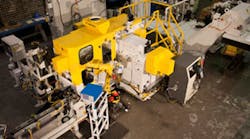C&B Machinery is a specialty designer and builder of grinding system — double-disc grinders, vertical spindle grinders, O.D. grinders, as well as grinders for special applications. Lately it improved the productivity and flexibility of its double-disc non-coplanar grinding system for connecting rods, introduced for the Chevrolet Volt 1.4L auxiliary engine in 2009.
The first grinding system produced a stepped connecting rod from a parallel (or coplanar) rod. The 1.4L Chevy Volt connecting rod has a 1.2- mm symmetrically smaller crankshaft end width, and both the pin and crank ends of the rod are ground in one sequence. At the time, the system was considered the most advanced double disc grinder ever produced by C&B.
This new system was shipped recently to Linamar Corp.’s Eston Manufacturing division in Guelph, Ont., where it is grinding a 1.8L connecting rod with a symmetrical reduction of the pin end of 3.8 mm. As with the initial machine design, the challenge was to develop a process for producing this part from a coplanar connecting rod in single operation. Stock removal from the pin end of the connecting rod is 5 mm, and stock removal from the crank end is 1 mm. Previously, producing the connecting rod required three separate grinding operations to complete and the crank and pin end were ground on two separate machines.
C&B’s application engineers took up the challenge, developing a special tooling package and a novel two-stage grinding cycle that first rough-grinds the pin end to a stock condition equal to the crank end. Then, it finish-grinds the crank and pin end of the connecting rod simultaneously. Grinding the crank and pin ends at the same time produces much greater symmetry between the two ends. Additionally the grinder easily exceeds Eston’s 1.67 Ppk requirements for size, parallel, and flatness.
The revised grinding system also includes a post-process gaging system with automatic feedback to the grinding wheel in-feed servos, providing automatic compensation for wheel wear. The gage inspects step relationships between the crank and pin end faces, too.
According to C&B, its model DG-2H-30/SA Connecting Rod grinding system is able to grind parallel parts, non-coplanar parts, pin end only, or crank end only configurations with very simple changeover. This is a notable advantage in view of modern manufacturing requirements -- lower volumes of production, greater flexibility and a constant demand to lower machining costs per piece.
The redesigned system is available in models that feature grinding wheels up to 42-in. diameter, so large connecting rods for diesel engines can be produced by this approach, too.








